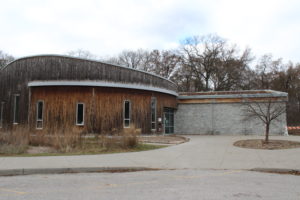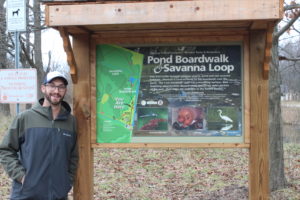Nature and technology connecting
Conservationists are using technology to strengthen efforts to protect natural habitats and help understand the environment.

The entrance to Ojibway Prairie Complex, located on 5200 Machette Rd. Photo by Tyler Clapp.
The World Wildlife Foundation is using methods such as acoustic sensors to measure species population and watching wildlife via remote cameras. Locally, the Essex Region Conservation Authority is one group aided by the merging of nature and technology.
“GIS [geographic information systems] mapping is used to calculate the existing percentages of various types of land uses including agriculture, development and natural areas coverage,” said Danielle Stuebing, communications and outreach services director for ERCA.
Geographic information systems gather data found in locations on the Earth’s surface like land usage, vegetation and income, according to National Geographic.
Mobile applications are being used by Tom Preney, biodiversity co-ordinator for Ojibway Prairie Complex on the west side of Windsor.
“One of the technologies we’re using right now is a nature-based app called iNaturalist. Anyone can use it and submit observations of plants and animals they find within the Ojibway Prairie Complex,” said Preney.
Created in 2008, the iNaturalist website describes the application as an online network that helps users learn and gather scientific data on nature. Users share photos and videos of plants and animals they find. These are then uploaded to the app’s database and shared with other users for examination.

Tom Preney is the biodiversity co-ordinator for Ojibway Prairie Complex. Photo by Tyler Clapp.
Measuring tools are crucial for conservation as well.
“We have a partnership with Campbell Scientific where we host five climate stations that provide real-time information on rainfall, temperature and sometimes wind conditions,” said Gina Pannunzio, partnerships and outreach coordinator of ERCA.
Climate stations use sensors measuring conditions like wind speed and humidity which are saved to a central datalog in the station. This information can help understand weather conditions and climate differences.
ERCA will be hosting a free Volunteer Fair Open House on Feb. 6 for those interested in helping conservation efforts locally. To learn more, visit www.essexregionconservation.ca/volunteerfairopenhouse2020. To register, tickets are sold at www.eventbrite.ca/e/volunteer-fair-open-house-tickets-88670191931.


